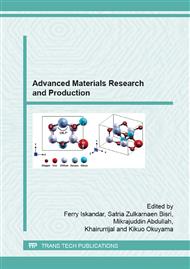p.241
p.245
p.251
p.256
p.262
p.266
p.271
p.275
p.279
Enhancing the Value of Local Silica Sand from Bancar as a Fuel-Cell Sealing Material
Abstract:
A prospective fuel cell sealing material using silica sand from Bancar, Tuban, East Java has been investigated. The investigation was aimed to enhance the value of such natural sand and was started by a treatment using magnetic separation and immersion with HCl to produce pure silica powder. Ceramic composites were then synthesized by a solid state reaction method by mixing the silica powder, magnesia (MgO), and 5-20wt% of boria (B2O3), pressing the mixture into pellets and finally sintering them at 1150 °C for 4 hours. By Archimedes method, it was found that the addition of B2O3 is favorable to reduce the porosity of composites with a maximum value reaching 0.68(0)% for the composite with 20% B2O3. An X-ray diffraction technique revealed that a liquid phase sintering had occurred, indicated by the appearance of quartz (SiO2), forsterite (Mg2SiO4) and protoenstatite (MgSiO3) in the sample without B2O3 and quartz and protoenstatite in the composites with 5 and 10 wt% of B2O3. Meanwhile, the composite SMB15h, in addition to quartz and protoenstatit, also contains a new phase, namely suanite (Mg2B2O5). In SMB204h, there are quartz and suanite.The phase compositions were determined using the Rietveld method from which thermal expansion coefficient values of 9.5-12 ppm °C-1 had been predicted. These results showed that natural-sand-based composites could fairly satisfy the required conditions of fuel-cell sealing materials.
Info:
Periodical:
Pages:
262-265
Citation:
Online since:
July 2015
Price:
Сopyright:
© 2015 Trans Tech Publications Ltd. All Rights Reserved
Share:
Citation:


